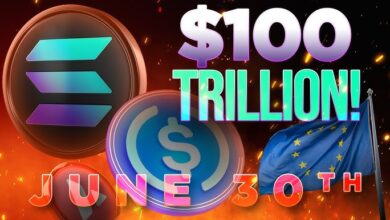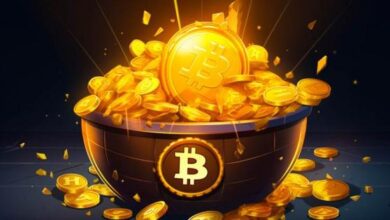The Rise and Rise of NFTs: Unveiling the Phenomenon of NFTs
WHAT IS NFTs? THE RISE OF NON-FUNGIBLE TOKENS IN CRYPTOCURRENCY

NFTs: In an era marked by technological innovation and digital transformation, the art and commerce spheres have undergone a seismic shift with the advent of Non-Fungible Tokens (NFTs). These cryptographic tokens have catalyzed a revolution, propelling artists, creators, and collectors into uncharted territory. The meteoric rise of NFTs has rewritten the rules of ownership, authenticity, and value, breathing life into the virtual domain like never before.

The NFT Revolution Unveiled
Navigating the NFT Landscape
At the forefront of the NFT revolution is the blockchain, a decentralized digital ledger that underpins the security and authenticity of these unique tokens. Unlike traditional cryptocurrencies, NFTs are indivisible and irreplaceable, granting them their distinctive value proposition. With the spotlight on blockchain’s immutability, creators can now prove the origin and provenance of their digital creations with unprecedented ease.
The Alchemy of Ownership and Scarcity
NFTs have elevated ownership to an entirely new level. Through fractional ownership, individuals can invest in and own fractions of high-value NFTs, democratizing access to exclusive assets. The concept of scarcity, a cornerstone of traditional art and collectibles, finds new expression in the digital realm. The intrinsic scarcity of NFTs, combined with their blockchain-backed authenticity, has fueled a frenzy of interest among collectors and investors alike.
The Artistic Metamorphosis: NFTs in the Art World
Empowering Artists
The art world has been fundamentally reshaped by NFTs, empowering artists to reclaim control over their work. Smart contracts embedded in NFTs enable creators to earn royalties every time their NFT changes hands, ensuring a sustainable income stream that eluded many traditional artists.
Redefined Aesthetics
Digital art, once relegated to the fringes, now takes center stage. Artists are experimenting with new mediums, blurring the lines between traditional and digital artistry. The concept of “ownership” takes on new meaning as collectors buy not just a physical object, but a piece of the artist’s legacy.
The Commercial Mettle: NFTs in Commerce
Gaming and Virtual Real Estate
NFTs have infiltrated the gaming industry, offering players true ownership of in-game items and characters. Virtual real estate markets have sprung up, where players can buy, sell, and monetize their digital land, revolutionizing the concept of a shared virtual universe.
Tokenizing Real-World Assets
Beyond the digital realm, NFTs are making inroads into tokenizing real-world assets, from real estate properties to rare luxury goods. This convergence of the virtual and physical worlds has the potential to reshape traditional industries, unlocking liquidity and accessibility.
The NFT Backlash: Challenges and Controversies
Environmental Concerns
The energy consumption of blockchain networks that support NFTs has raised concerns about their environmental impact. As the demand for NFTs grows, so does the pressure to develop more eco-friendly blockchain solutions.
Copyright Conundrums
The borderless nature of the digital realm has sparked debates about copyright enforcement and intellectual property rights. NFTs have exposed the complexities of ownership, leading to legal battles and calls for regulatory clarity.
FAQs
What exactly is an NFT?
An NFT, or Non-Fungible Token, is a unique digital token that represents ownership of a specific item, artwork, or collectible using blockchain technology.
Why are NFTs considered valuable?
NFTs derive value from their scarcity, provenance, and blockchain-backed authenticity, which can be verified on the decentralized ledger.
How do NFTs empower artists?
NFTs enable artists to retain ownership and earn royalties every time their creations are sold, providing a sustainable income stream.
Are NFTs only used for art?
No, NFTs have expanded beyond art into various domains, including gaming, virtual real estate, music, and even tokenizing real-world assets.
What is the environmental impact of NFTs?
The energy consumption of blockchain networks supporting NFTs has raised environmental concerns, spurring discussions about sustainable solutions.
Can I buy fractional NFTs?
Yes, fractional ownership of high-value NFTs is possible, allowing multiple investors to share ownership and potential returns.
How do NFTs relate to virtual reality?
NFTs have paved the way for virtual real estate markets, where users can buy, sell, and monetize digital land within virtual reality environments.
Are copyright issues a concern with NFTs?
Yes, the borderless nature of the digital realm has triggered debates about copyright enforcement and intellectual property rights for NFT-based creations.
What industries are NFTs disrupting?
NFTs are disrupting not only the art world but also gaming, entertainment, fashion, and finance by revolutionizing ownership and transaction mechanisms.
How can I get started with NFTs?
To get started with NFTs, you can explore NFT marketplaces, create your own NFTs, or engage with communities discussing the latest trends and developments.
Conclusion:
The rise and rise of NFTs stands as a testament to human innovation and our ability to transform the intangible into tangible value. From revolutionizing how we define ownership to ushering in a new era of artistic expression, NFTs have catalyzed a digital renaissance. As technology continues to evolve and find its place in an ever-changing landscape, one thing remains clear: the phenomenon of NFTs is far more than a trend—it’s a paradigm shift that has rewritten the rules of the digital age.



